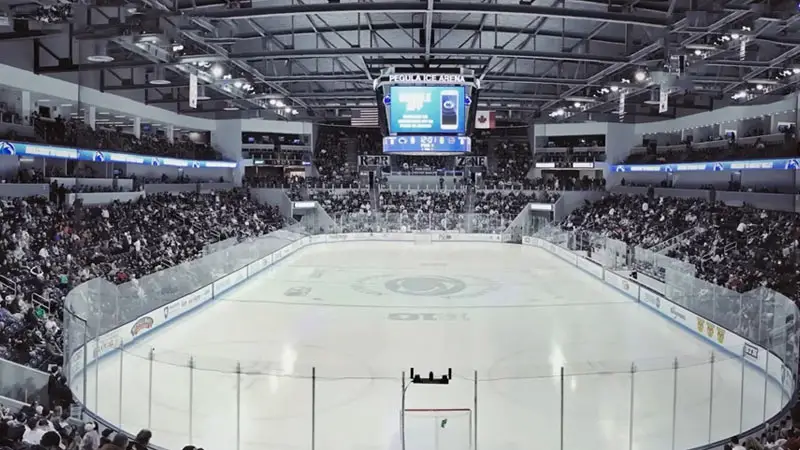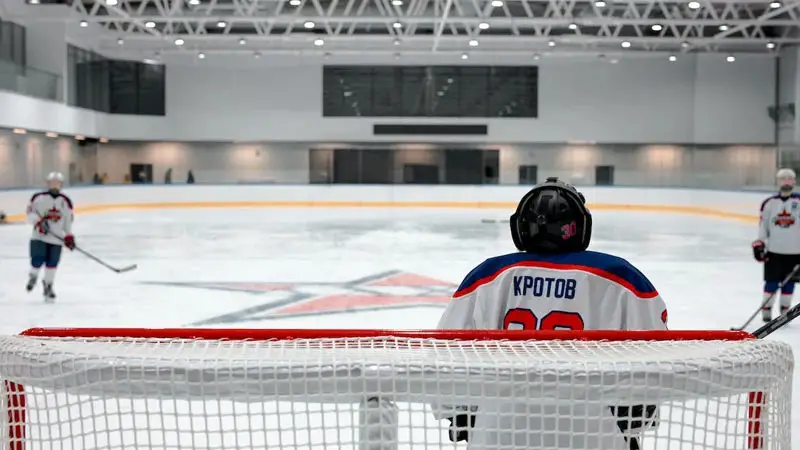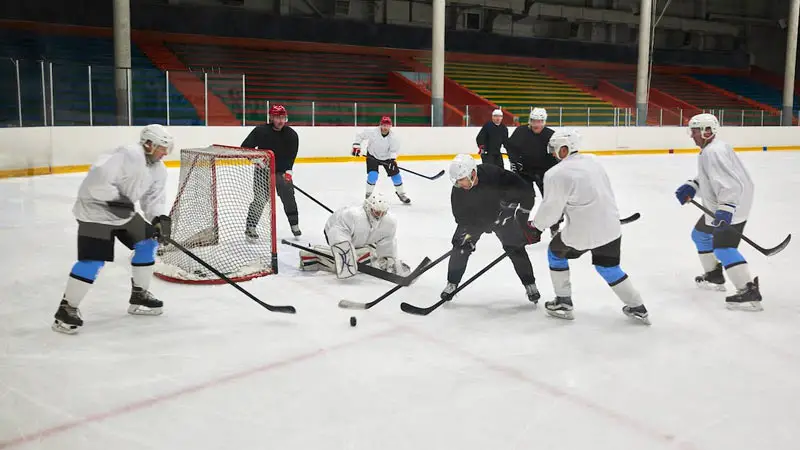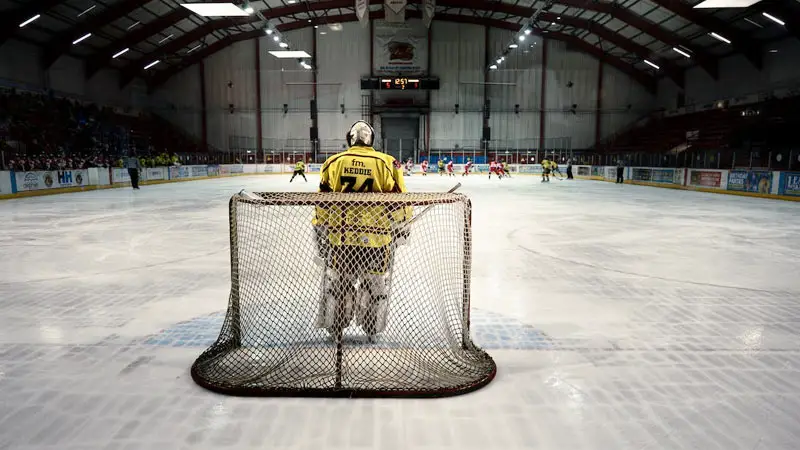Hockey enthusiasts and casual viewers alike often find themselves engrossed in the thrilling world of NHL games, but have you ever wondered about what is the average length of an NHL game?
In the fast-paced realm of professional hockey, each second counts, and the length of a game is influenced by various factors.
From regulation periods and overtime to penalties and strategic pauses, the dynamics of an NHL game contribute to its overall duration.
This blog post delves into the intricacies of what defines the average length of an NHL game, exploring the elements that shape this temporal landscape and providing insights into the evolving nature of hockey spectacles. So, stay sharp.
The Basics of an NHL Game Duration
The National Hockey League (NHL) is known for its fast-paced and exciting gameplay, capturing the hearts of millions of fans worldwide.
Understanding the basics of an NHL game duration is crucial for both avid followers and newcomers to the sport. Here, we delve into the key aspects that define the time frame of an NHL game.
Regulation Periods
The standard NHL game consists of three regulation periods, each lasting 20 minutes of actual playing time.
However, the clock is stopped whenever play is halted, resulting in the overall duration of a regulation period often exceeding 20 minutes.
These intermissions provide teams with the opportunity to strategize and allow for necessary game-related activities.
Overtime
In the event of a tied score at the end of the third regulation period, an overtime period is introduced. Overtime lasts for a sudden-death period of 5 minutes.
Unlike the regulation periods, overtime is played with a reduced number of skaters on each team, creating more open ice and higher scoring chances.
If a team scores during overtime, they secure the victory; otherwise, the game proceeds to a shootout.
Shootouts
If the game remains tied after the overtime period, a shootout follows. The shootout involves a series of one-on-one attempts by selected players from each team against the opposing goaltender.
Each team is granted three attempts, and the team with the most goals at the end of this phase is declared the winner. If the shootout is still tied, additional rounds are played until a winner is determined.
Game Duration Variation
While the standard game duration is structured as mentioned above, unforeseen circumstances such as injuries, penalties, or video reviews can extend the overall time.
Stoppages in play, especially during critical moments, may influence the duration of an NHL game, making it difficult to predict an exact end time.
Playoff Overtime Differences
In NHL playoff games, the overtime format differs from the regular season. Instead of a shootout, playoff games continue with sudden-death overtime periods until a goal is scored, regardless of the duration.
This format adds an extra layer of intensity and drama to playoff matchups, as teams battle relentlessly for a decisive victory.
Understanding these aspects of NHL game duration not only enhances the spectator’s experience but also provides a comprehensive view of the intricacies involved in the sport.
What Is the Average Length of An NHL Game?

The average length of an NHL game is approximately 2 hours and 20 minutes. This duration encompasses three regulation periods, each lasting 20 minutes of actual playing time.
However, the clock stops during various stoppages, including penalties, timeouts, and instances when the puck goes out of play.
These interruptions, along with intermissions between periods, contribute to the overall game duration.
In the regular season, if the game remains tied after the third period, an overtime period of 5 minutes is added. In cases where a shootout is needed to determine the winner, additional time is required.
While the 2 hours and 20 minutes provide a general guideline, variations may occur due to factors like penalties, injuries, and video reviews, influencing the actual time it takes to complete an NHL game.
Factors Influencing Game Length
The duration of an NHL game is influenced by a multitude of factors, ranging from the intrinsic nature of the sport to external circumstances that can extend or shorten the overall playing time.
Understanding these factors provides insights into the dynamic nature of hockey matchups.
Penalties and Power Plays
Penalties, whether minor or major, lead to stoppages in play and can significantly impact the overall game length.
Power plays, where one team has more players on the ice due to an opponent’s penalty, create strategic advantages but also extend the duration as teams capitalize on these opportunities.
Injuries and Medical Stoppages
Instances of player injuries necessitate stoppages for medical attention, affecting the game’s tempo and contributing to extended durations.
The severity of injuries and the time required for medical assessments can vary, making it challenging to predict the exact length of a game.
Video Reviews
The introduction of video reviews for contentious goals or plays adds an element of precision to officiating but also extends the game time.
Referees and officials take the necessary time to ensure accurate decisions, contributing to occasional delays during critical junctures of a match.
Timeouts and Coaching Strategies
Teams strategically use timeouts to regroup, discuss tactics, and provide players with brief rests. These strategic breaks, coupled with coaching decisions, contribute to the overall game duration.
Coaches may adjust their strategies based on the flow of the game, influencing the frequency and timing of stoppages.
Television Broadcast Considerations
External factors, such as television broadcasting requirements and commercial breaks, contribute to the duration of an NHL game.
Television timeouts, and scheduled breaks for advertising, impact the pace of play and introduce additional pauses, particularly at certain junctures of the game.
The dynamic interplay of these factors, inherent to the nature of hockey and external considerations, shapes the length of an NHL game.
Historical Trends Regarding NHL Game Duration

Examining historical trends regarding NHL game duration provides valuable insights into how the pace and structure of hockey matchups have evolved over time.
Various factors, including rule changes and shifts in playing styles, have contributed to alterations in the length of NHL games.
Expansion of Video Review
Over the years, there has been an expansion in the use of video review to ensure accurate officiating.
This implementation, while enhancing the fairness of decisions, has contributed to an increase in the average duration of NHL games.
The meticulous review of goals, especially during critical moments, has become more prevalent in recent seasons.
Rule Changes and Game Flow
The NHL has periodically introduced rule changes aimed at enhancing the speed and flow of the game.
Historically, alterations to rules such as reducing the size of goaltender equipment and enforcing stricter interference penalties have impacted the overall pace, sometimes leading to variations in game duration.
Strategic Timeouts and Commercial Breaks
The introduction of strategic timeouts and considerations for television broadcasts have influenced historical trends in game duration.
Teams strategically use timeouts, and the scheduling of commercial breaks has evolved, affecting the rhythm and overall time required to complete a game.
Overtime Formats
Changes in the overtime format, particularly in the regular season, have impacted game lengths.
The implementation of 3-on-3 overtime and the subsequent shift to a shootout format in tied games have introduced more dynamic and time-sensitive elements to overtime periods, influencing historical trends.
Emphasis on Player Safety
The league’s increased emphasis on player safety has led to changes in rules related to hits and checks.
While these changes are vital for the well-being of players, they can contribute to more frequent stoppages, affecting the overall duration of NHL games.
Understanding these historical trends offers a broader perspective on the factors that have shaped the length of NHL games.
Strategies Used by Teams to Manage Game Duration

In the dynamic and fast-paced world of NHL hockey, teams employ various strategies to manage game duration effectively.
These strategies, ranging from in-game tactics to off-ice preparations, play a crucial role in navigating the unpredictable elements that can influence the length of a game.
Efficient Line Changes
Teams strategically manage player rotations to maintain fresh and energized skaters on the ice.
Quick and efficient line changes during stoppages in play help teams sustain high levels of intensity and reduce the impact of player fatigue, ultimately contributing to better game management.
Strategic Use of Timeouts
Coaches strategically deploy timeouts to provide players with necessary rest, discuss tactics, and regroup during critical junctures.
Well-timed timeouts not only allow teams to catch their breath but also disrupt the flow of the opposing team, influencing the overall rhythm of the game.
Discipline and Penalty Avoidance
Teams emphasize discipline to minimize penalties and avoid unnecessary stoppages.
Penalties not only disrupt the flow of the game but also result in power plays for the opposing team, impacting both game duration and the overall strategic balance.
By maintaining discipline, teams can exert better control over the game’s tempo.
Adaptation to Rule Changes
Teams stay proactive in adapting to rule changes implemented by the league.
Understanding how alterations in rules, such as those related to goaltender equipment or interference, can impact the game allows teams to adjust their playing styles and strategies accordingly, influencing the overall duration.
Fitness and Endurance Training
Off-ice preparations play a crucial role in managing game duration. Teams invest in rigorous fitness and endurance training programs to ensure that players can sustain a high level of performance throughout the game.
Improved fitness not only aids in avoiding fatigue-related errors but also contributes to a more efficient pace of play.
By employing these strategies, NHL teams aim to strike a balance between maintaining a high level of intensity and managing the various factors that can influence game duration.
FAQs
How long does a typical NHL game last?
A standard NHL game lasts approximately 2 hours and 20 minutes.
This duration includes three regulation periods, each lasting 20 minutes of actual play, as well as intermissions and potential overtime or shootouts if the game remains tied.
Why do NHL games sometimes go beyond the expected duration?
NHL games can extend beyond the expected duration due to various factors like penalties, injuries, video reviews, and strategic timeouts.
These interruptions and events during the game can lead to additional stoppages, influencing the overall length of the match.
Are there differences in game duration during the playoffs?
Yes, playoff games may have different durations. In the playoffs, overtime periods are continuous sudden-death until a goal is scored.
This format contrasts with the regular season, where a shootout is used if the game remains tied after a 5-minute overtime.
How do penalties affect the length of an NHL game?
Penalties can significantly impact game length. When a penalty occurs, play is stopped, and the penalized team plays short-handed.
Power plays and penalty kills introduce additional dynamics and stoppages, influencing the overall flow and duration of an NHL game.
Does the average game duration vary across NHL seasons?
While the standard game duration is around 2 hours and 20 minutes, variations can occur from season to season.
Rule changes, officiating styles, and other factors may influence the pace and flow of games, contributing to subtle fluctuations in the average length of NHL matchups.
Wrapping Up
In the heart-stopping world of NHL action, time is both an ally and a foe.
As we dissected the components influencing the average length of an NHL game—regulation periods, overtime, penalties, and strategic decisions—we gained a deeper appreciation for the sport’s fluidity.
Whether it’s the unrelenting pace of playoff overtime or the strategic use of timeouts, each element contributes to the unique temporal landscape of hockey.
As the NHL continues to evolve, so too does the ebb and flow of its games, ensuring that every second on the ice is a captivating part of the ongoing narrative that keeps fans on the edge of their seats. Thank you for your support.





James Felix